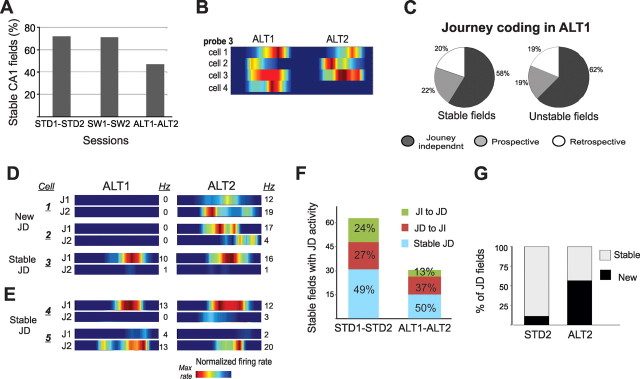Figure 8.
CA1 place fields remapped between ALT1 and ALT2 but journey coding remain strong. A, Most CA1 cells (∼70%) had stable place fields on the same arm in repeated STD or SW sessions, but only 47% of the cells with place fields in ALT1 had place fields on the same arm in ALT2 (Bahar et al., 2011). B, Unstable and stable place fields were often recorded together by the same tetrode. C, The proportion of journey-dependent place fields recorded during ALT1 was similar in cells with stable and unstable place fields. D, The firing rate maps show the activity of three cells recorded by the same tetrode across ALT1 and ALT2 sessions. Cells 1 and 2 fired on the waiting platform, were silent during ALT1, but had journey-dependent (JD) place fields in ALT2. Cell 3 had stable JD activity in both sessions. E, Cells 4 and 5, recorded simultaneously from another tetrode, showed stable JD activity across ALT1 and ALT2. F, The number of place fields that were identified in both repeated sessions (stable place fields) and were journey-dependent in at least one session was higher across repeated STD (62) than ALT (30) sessions, indicated by the height of the stacked bars (STD1 versus STD2 (left) and ALT1 versus ALT 2 (right). The smaller height of the ALT bars reflects the decline of place field stability in this task rather than a reduction in the number of place fields per se. The fate of these stable place fields with respect to journey coding is shown by the colors (as described in caption 5D). Similar proportions of stable JD place fields were recorded across repeated STD and ALT sessions (∼50%) even though the absolute number of stable place fields was greater in the STD. JI, Journey independent. G, The stacked columns show the proportion of journey-dependent place fields recorded in the second session that had a place field of any type in the first session. The gray stack in the left column shows the proportion of cells with journey-dependent place fields in STD2 that also had place fields in STD1; the black stack shows the proportion of cells that had no place field in STD1. These proportions were significantly different across repeated ALT sessions (right column), when many new place fields emerged (Bahar et al., 2011). Moreover, new JD codes were more common in newly emerged place fields in ALT 2 (25/48, 52%) than in the place fields that were stable across ALT1 and ALT2 (4/19, 21%) (χ2(1) = 5.3, p < 0.03).

